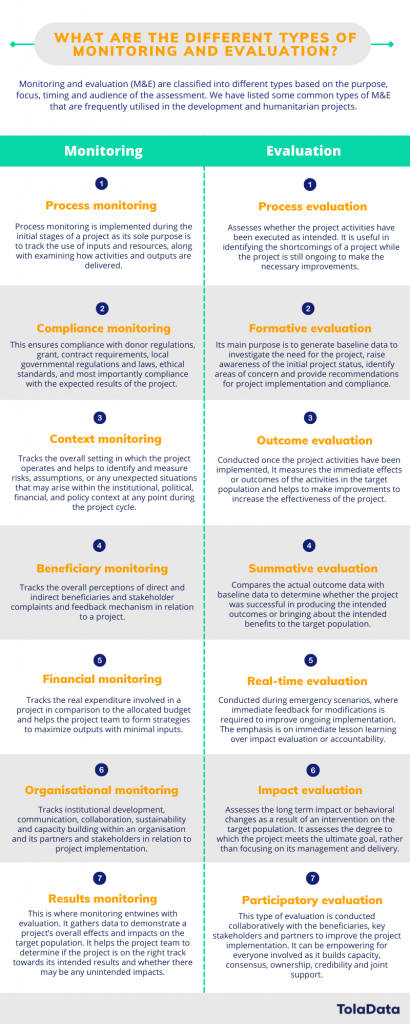What are the different types of Monitoring and Evaluation (M&E)?
May 28, 2019
Did you know that monitoring and evaluation (M&E) are classified into different types based on the purpose, focus, timing and audience of the assessment? In this article, we have attempted to explore the variety that is commonly used in the development and humanitarian sector to help you plan and execute your M&E more strategically.
Great news is, the variations of monitoring and evaluation are not mutually exclusive, which means that they can be used in different combinations to leverage the full potential of your project.
Before we jump into the types, let’s quickly explore how monitoring differs from evaluation.
7 types of monitoring to get you started
Process monitoring
This is often referred to as ‘activity monitoring.’ Process monitoring is implemented during the initial stages of a project as its sole purpose is to track the use of inputs and resources, along with examining how activities and outputs are delivered. It is often conducted in conjunction with compliance monitoring and feeds into the evaluation of impact.
Compliance monitoring
Just as the name suggests, the purpose of compliance monitoring is to ensure compliance with donor regulations, grant, contract requirements, local governmental regulations and laws, ethical standards, and most importantly compliance with the expected results of the project. The need for compliance monitoring could arise at any stage of the project life cycle.
Context monitoring
Context monitoring is often called ‘situation monitoring.’ It tracks the overall setting in which the project operates. Context monitoring helps us identify and measure risks, assumptions, or any unexpected situations that may arise within the institutional, political, financial, and policy context at any point during the project cycle. These assumptions and risks are external factors and are not within the control of the project, however, context monitoring helps us identify these on time to influence the success or failure of a project.
Beneficiary monitoring
This type of monitoring is sometimes referred to as ‘Beneficiary Contact Monitoring (BCM)’ and the need for this may arise at any stage of the project cycle. Its primary purpose is to track the overall perceptions of direct and indirect beneficiaries in relation to a project. It includes beneficiary satisfaction or complaints with the project and its components, including their participation, treatment, access to resources, whether these are equitable, and their overall experience of change. Beneficiary monitoring also tracks stakeholder complaints and feedback mechanism.
Financial monitoring
The main purpose of financial monitoring is to measure financial efficiency within a project. It tracks the real expenditure involved in a project in comparison to the allocated budget and helps the project team to form strategies to maximize outputs with minimal inputs. This is often conducted in combination with ‘process’ and ‘compliance’ monitoring and is crucial for accountability and reporting purposes.
Organisational monitoring
As the name suggests, organisational monitoring tracks institutional development, communication, collaboration, sustainability and capacity building within an organisation and with its partners and stakeholders in relation to project implementation.
Results monitoring
This is where monitoring entwines with evaluation. It gathers data to demonstrate a project’s overall effects and impacts on the target population. It helps the project team to determine if the project is on the right track towards its intended results and whether there may be any unintended impacts.
10 types of evaluation to put you on the right track
Formative evaluation
This is generally conducted before the project implementation phase. But depending on the nature of the project, it may also continue through the implementation stage. Its main purpose is to generate baseline data to investigate the need for the project, raise awareness of the initial project status, identify areas of concern and provide recommendations for project implementation and compliance.
Process evaluation
It is conducted as soon as the project implementation stage begins. It assesses whether the project activities have been executed as intended and resulted in certain outputs. Process evaluation is useful in identifying the shortcomings of a project while the project is still ongoing to make the necessary improvements. This also helps to assess the long-term sustainability of the project.
Outcome evaluation
This type of evaluation is conducted once the project activities have been implemented. It measures the immediate effects or outcomes of the activities in the target population and helps to make improvements to increase the effectiveness of the project.
Summative evaluation
This occurs immediately after project conclusion to assess project efficacy and the instant changes manifested by its interventions. Summative evaluation compares the actual outcome data with baseline data to determine whether the project was successful in producing the intended outcomes or bringing about the intended benefits to the target population. It provides evidence of project success or failure to the stakeholders and donors to help them determine whether it makes sense to invest more time and money for project extension.
Impact evaluation
Impact evaluation assesses the long term impact or behavioral changes as a result of a project and its interventions on the target community or population. It assesses the degree to which the project meets the ultimate goal, rather than focusing on its management and delivery. These typically occur after project completion or during the final stage of the project cycle. However, in some longer projects, this can be conducted in certain intervals during the project implementation phase, or whenever there is a need for impact measurement.
Real-time evaluation
Real-time evaluation is undertaken during the project implementation phase. It is often conducted during emergency scenarios, where immediate feedback for modifications is required to improve ongoing implementation. The emphasis is on immediate lesson learning over impact evaluation or accountability.
Participatory evaluation
This type of evaluation is conducted collaboratively with the beneficiaries, key stakeholders and partners to improve the project implementation. Participatory evaluation can be empowering for everyone involved as it builds capacity, consensus, ownership, credibility and joint support.
Thematic evaluation
Such type of evaluation focuses on one theme across a number of projects, programs or the whole organisation. The theme could be anything, ranging from gender, migration, environment etc.
Cluster or sector evaluation
Just as the name suggests, this evaluation is implemented by larger development and humanitarian sectors, including a group of different organisations, programs or projects that are working on similar thematic areas. It assesses a set of interconnected activities across different projects and entities. As a result, it strengthens partnerships within these key sectors, while improving their coordination, accountability, predictability, and response capacity.
Meta-evaluation
This is used to assess the evaluation process itself. Meta-evaluations could be useful to make a selection of future evaluation types, check compliance with evaluation policy and good practices, assess how well evaluations are utilized for organizational learning and change, etc.
Here’s the summarized version of the different types of monitoring and evaluation (M&E) we have listed above.

Quick note: Monitoring is conducted by an internal staff member, whereas, evaluations, depending on its type, could be conducted by internal team members or external consultants/experts. Internal evaluation could help build staff capacity and ownership but they may be subjective at times. On the other hand, external evaluation brings in a degree of objectivity and technical expertise and tends to be more transparent and accountable.
The content in this article is based on the International Federation of Red Cross and Red Crescent’s Project/Program Monitoring and Evaluation Guide.
Before we sign off, just a quick reminder that this list is not all-inclusive and there are many more types of monitoring and evaluation practiced in the development and humanitarian sectors. If you know of any additional types that you would like to see on this list then do reach out to us and we’d be happy to add them here.
By Chandani Lopez Peralta, Content Marketing Manager at TolaData.


This is fantastic and educative
Good summary of the differences and kinds of M&E.
Thank you, Annabelle!
Thank you for your wonderful feedback, Dr Saka Akinade!
Thanks for the great contribution you have made, I would like to know more about monitoring and evaluations.
Thank you for your feedback! If you would like to learn more about the basics of M&E then you might find this article helpful: https://www.toladata.com/blog/what-is-monitoring-and-evaluation/.
Thank you for your feedback! You can reach us on info@toladata.com or on the live chat function at the bottom right-hand side of the page.
Thank you very much, I’m interested in reading more on M&E.
You are most welcome, A. Franklin! Please visit our blog section for more articles and resources on M&E — https://www.toladata.com/blog/
I really gained a lot, in reading on M & E. Regards.
So glad to hear that, Lodi!
it was a good idea to have an extra or additional information from this text.
Glad to hear that, NGS!
Thank you so much for the educative material. It clearly spells out the difference between M and E. But would be nice if you could also explain the relationship between M and E
Djax Sanga Biria
Thank you for your feedback, Djax Sanga Biria! That sounds like a great topic for our next blog post. 🙂
It’s so educative and I learned a lot. Thank you.
You are most welcome, Elican!
This was so helpful. Thanks.
You are most welcome and so glad to hear that you found this article helpful, Joelyn!
Thank you so much for the clearly explained M & E. Still looking forward to learn more about monitoring and evaluation.
Thank you, Indrah! So happy to hear that you found this article helpful. Please visit our blog section for more resources on M&E — https://www.toladata.com/blog/
quite educative thanks
You are most welcome, Paul!
Beautifully-written summary of the types of M&E. One question — what is the name for monitoring completed post-activity (i.e. a quarterly monitoring activity with an expected data lag of ninety (90) days).
very educative , i have learnt a lot from this.
Thanks for your feedback, Naume!
Succinctly put; very informative and surely helps me with my RD&E endeavors. Thank you for sharing.
Glad to hear that, Kris!
monitoring and evaluation is the most important part of life thanks for sharing this valuable information I will definitely search more about it.
M&E certainly plays a key role in international development. Thanks for your wonderful feedback!
This is so excellent..it can’t be any better..thanks so much
Thanks for your wonderful feedback, Jonathan!
I liked the approach
Excellent summary! Understandable with excellent linkage between monitoring and evaluation. Thank you very much for sharing your thoughts! Mary
Thank you for sharing that excellent and useful summary.
Thanks for your wonderful sharing information
I was also searching for this information and i appreciate your sharing
The information shared is extremely helpful! Thank you for sharing!
This piece of information on M&E is very useful and it has really broaden my idea and understanding on the concept of M&E. Thank you so much and hope to see more post which will help me more as I’m still gaining more knowledge on M&E.
Very good write up and very detailed.
Nice effort. Overall, the approaches explained here are consistent with the standard practices, however, a few improvements are also needed. For example, the definition of Process Evaluation is vague. The primary aim of any Process Evaluation is to compare actual practices to the predefined standard Operating Procedures (SoPs), manuals, benchmarks, or criteria. Unlike Spot Checks, the Process Evaluations are designed to carry out thorough examination of the existing end-to-end processes and practices. For example, a detailed assessment of the processes in place for beneficiary identification, and enrolment and participation in, and exit from a project or a program.
Thanks you 🙏❤😍